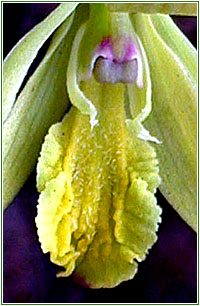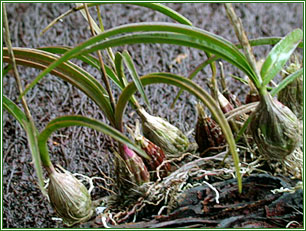Key-words:
Brazil, Espírito Santo, Atlantic Forest,
Orchidaceae, Pseudolaelia
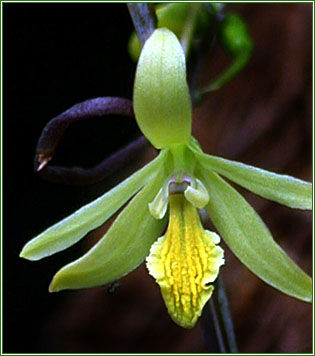 |
|
Abstract
This paper describes Pseudolaelia maquijiensis M. Frey, a species
recently found in the mountain ranges of Espírito Santo, Brazil.
It is related to and compared with P. citrina Pabst. Information
on its ecology and geographic occurrence is given.
Introduction
The genus Pseudolaelia Pôrto & Brade comprehends
nowadays 10 species (Withner, 1994) including Pseudolaelia canaanensis
(Ruschi) Barros, transferred by Barros (1994) based on Renata
canaanensis Ruschi, P. brejetubensis M. Frey, species described
in 2003 and P. freyi Chiron & V.P. Castro, described in
2004. Those species are distributed in the Brazilian southeast where
are found mainly in the states of Espírito Santo and Minas
Gerais, a little in Rio de Janeiro and Bahia (Pabst & Dungs, 1975).
They are found exclusively on granitic inselbergs which characterize
the relief of this region, with a xerophyte vegetation and high endemism
(Porembski et al. 1998). The species described is a good example of
this endemism since it has, until today, just found on this inselberg
and in reduced number. This paper describes this species, gives information
on its ecology and geographic distribution and compares it with the
near species, Pseudolaelia citrina Pabst.
Pseudolaelia
maquijiensis M. Frey.
Richardiana Vol. V(1).39:45. January 2005
Planta herbacea, lithophila, in genero parva, Pseudolaelia citrina
Pabst affinis, sed omnino major, inflorescencia paniculata, floribus
satis majoribus et tote sulphureis
TYPUS:
Brazil, Espírito Santo, in boundary between Baixo Guandu and
Colatina counties, Morro do Maquiji, 19° 29’ 55’’
S, from 40° 50’ to 40° 52’ W, at about 700 m altitude,
May 2004 (blooming), M. Frey 655 & L. C. F. Perim (Holotypus :
MBML, Isotypus LY).
Description
Rhizome 5-6 mm diameter recovered by scarious sheaths;
2-3(5) roots simples, whitish, thin, arising from the
internodes of the rhizomes; ovoid pseudobulbs, 3-4 cm
distant, 3-4 cm tall, 1,8 cm wide, slightly flattened, 4-6 internodes,
recovered by apressed sheaths when young, then bared, violaceous and
plurisulcate; distic leaves 2-3, until 100 × 7
mm, emerging of the apex of the pseudobulb, involving the peduncle
at the base, after spread, linear-acute, caniculate in length, 1 mm
thick, green slightly purple, bare, smooth purple margins, tip slightly
dissimetric; inflorescence arising from the apex of
the pseudobulb, reaching 30(40) cm tall, 2,5 mm diameter at the base,
recovered by scarious imbricate sheaths, number 7-10, the superior
allowing to see the purple peduncle ; rachis paniculate, 3-4(6) branches,
each branch having in its base an enveloping bract which goes until
the next branch, branches with (2)3-5(6) flowers; purple sub-peduncle,
1 mm diameter, having triangle-acute bracts, 1,5-2 mm long; pedicel
with ovary, 20 mm long (ovary com 8-9 mm), green slightly
purple at the base, becoming clearly green at the ovary, 0,7 mm diameter
1,5 mm at the ovary; flower slightly nutans, wide open,
yellow, membranous sepals, 13 mm long, 3,5 mm wide, narrowly elliptic,
yellow, slight greenish, glabra, with smooth borders, 7 veins somewhat
in relief at the abaxial side, mainly the median, the dorsal with
rounded extremity, with slightly curved margins, the laterals are
spread, with an extremity slightly concave and obtuse-apiculate; membranous
petals, 13-14 mm long versus 2 mm wide spread, narrowly
ob-oval, glabra, smooth margins, concave apiculate round extremity;
lip 13 mm long, 5,5 mm wide in the natural position
(8 mm with the lateral lobes spread), fused to the column until the
half, 3-lobed, formed by a small nail 3 mm long fused to column, then
the lateral lobes, 4 mm long, 1 mm wide, somewhat falciform, curved,
surrounding the column, acute extremity, spreading itself in a median
oval lobe provided with a small nail 2mm long, 2,5 mm wide, a limb
6,5 mm × 5,5 mm, yellow-lemon, callus formed by a small nail
of two parallel carenes by semi-cylindrical section, dividing inside
the lobe into 7 carenes , membranous and strong undulated periphery;
column 6 mm long, 1 mm wide becoming 2, finishing by
two wings round towards down, apiculate in the extremity, green, central
stigma forming a 'V', green surrounding by purple, biggibous anther,
green-purplish, 8 yellow-golden pollinia, in two groups of 4, discoid,
subequal
see drawing 1 and photography.
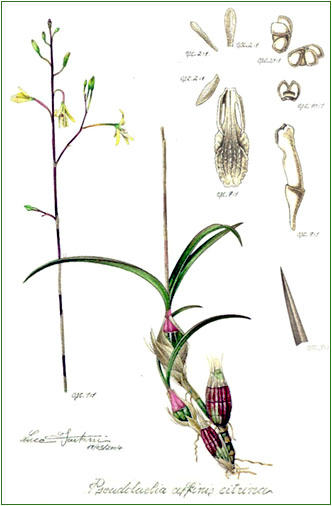
figure 1 |
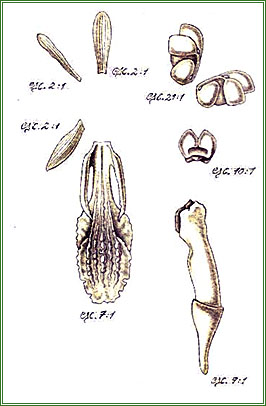
detail |
Etymology
The name of the species is derived from « Morro do Maquiji »,
typical inselberg of Colatina-Baixo Guandu region, Espírito
Santo, Brazil, where the plant has been found (until today, exclusively).
Habitat and
geographic distribution
P. maquijiensis is found on the surface of « Morro do
Maquiji », in the boundary of the Colatina and Baixo Guandu
counties, in the center of Espírito Santo, Brazil. It is sympatric
to P. dutrae Ruschi, which flowers are pink. It is presumed
to be exclusively lithophyte, in small clumps over bared and exposed
parts of the hill. Blooming in May
Discussion
Pseudolaelia maquijiensis grows in an area located in the
peak of the Morro do Maquiji, which is in the boundary of Colatina
and Baixo Guandu, at the north of Rio Doce, Espírito Santo.
There, it is sympatric to P. dutrae (Ruschi), with pink flowers.
It grows on lithosolo found on the rock and avoids areas with vegetation.
Blooming in May and June.
The yellow flowers species of Pseudolaelia
are not numerous and, if we put aside Pseudolaelia canaanensis
(Ruschi) Barros, which is a big size species, this new species can
only compared with Pseudolaelia citrina Pabst (in Bradea, Vol
II, N°12, pp 69-70). Both are small and lithophyte (not "vellozicola"
as Pabst said about Pseudolaelia citrina), with very close
pseudobulbs (3-4 cm to P. maquijiensis versus 1 cm to P.
citrina), small (3-4 × 1,8 cm versus 2 × 1,2 cm) with
4-6 internodes (versus 3), the sheaths and the surface of P. maquijiensis
become clearly pink-purplish with the age, with similar leaves although
bigger in this new species (100 × 7 mm versus 40-70 ×
5 mm), a bigger inflorescence (30-40 cm versus 14 cm) in general paniculate
with many ramifications. Pabst didn't mention this fact to P. citrina,
but we found certain big specimens with one or two ramifications.
The flowers are flattened in Pseudolaelia citrina and a little
nutans in P. maquijiensis, and especially bigger in our species
(13 × 3,5 mm sepals versus 8 × 1,6-2 mm, 13,5 lip ×
5,5 mm versus 9,5 × 4 mm), with a yellow-sulphur coloration
and locally greenish in P. maquijiensis, while in P. citrina,
if the lip is quite yellow, a little more orange than the other, on
the other hand, it has hues of pink purplish in the interior and become
clearly to this color at the outside with stronger ridges. Besides,
we can notice that P. citrina grows at about 1 200 m altitude
while P. maquijiensis is found up to 700 m.
Bibliography
Barros, F., 1994. Novas combinações, novas occorrências
e notas sobre espécies pouco conhecidas para as orquideas do
Brazil. Acta Botanica Brazilica 8(1) :11-17
Frey, M., 2003. Pseudolaelia brejetubensis M. Frey (Orchidaceae),
uma nova espécie do Espirito Santo, Brazil. Bradea, 9(8):33-36
Chiron, G. & V.P. Castro Neto, 2004. Une nouvelle espèce
de Pseudolaelia (Orchidaceae: Laeliinae ) d’Espirito
Santo. Richardiana, IV(4) :155-162
Pabst, G. F. J. & F. Dungs, 1975. Orchidaceae Brazilienses, vol
1, K Schmersow, Hildesheim
Porembski, S., G. Martinelli, R. Ohlemüller & W. Barthlott,
1998, Diversity and ecology of saxicolous vegetation mats on inselbergs
in the Brazilian Atlantic rainforest. Diversity and distribution,
4:107-119
Withner, C. L, 1993. The Cattleyas and their relatives, vol III, 105-109,
Timber Press, Portland USA
Photo: Michel Frey
Illustration: Luca Fontani.
Thanks
To Euclidio Colnago the first one to talk to us about the Morro do
Maquiji.
To Mrs. Onorina Barbieri Spelta and her family by their hospitaly
and guide.

